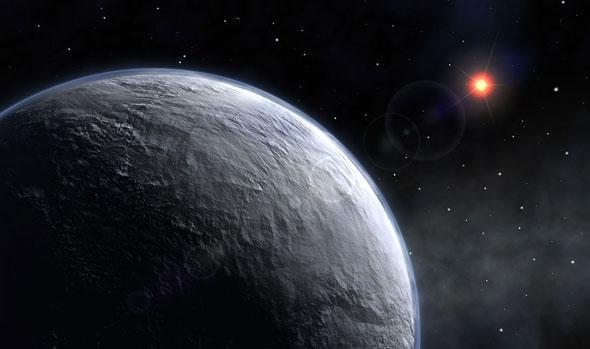Reading light helps locate Earth-like planets
Thanks to the ability to detect the occurrence of extraterrestrial planets orbiting distant stars, scientists are now able to study hundreds of solar systems. Now researchers are from the Harvard-Smithsonian Center for Astrophysics in Cambridge, Mass. has built an 'astronomical comb' that helps astronomers detect lighter, rather Earth-like planets, orbiting distant stars.
The Harvard team will publish their findings in the 2009 conference on laser and electroplating optics / International Quantum Electronic Conference (CLEO / IQEC) starting May 31 to June 5 at Baltimore Convention Center.
We cannot observe extraterrestrials directly because the light of nearby stars is too strong, but spectroscopic images can help identify them. Spectroscopy analyzes the energy of the light spectrum emitted by stars. The spectroscopy not only revealed the identity of the atoms in the star (each element emitted light at a specific frequency), it could also tell researchers that the star is moving away from it. how fast the Earth is directed by the Doppler effect, which occurs whenever a wave source moves. By recording changes in the frequency of waves emerging from an object, scientists can calculate the velocity of the object.
The above process is used to determine the velocity of cars, storm systems and stars. So how is it applied to detect the appearance of a planet? Although the planet may be inferior to stars millions of times, stars may be jerky a little due to the gravitational interaction between stars and planets. This jerky phenomenon causes that star to move toward or away from the Earth somewhat depending on the mass of the planet and its proximity to the star. The more effective spectroscopy is used in this process, the easier it is to identify the crystal right from the first time, and at the same time, determine the characteristics of the planet. Currently standard spectroscopic techniques can determine the star's motion within a few meters / s. In experiments, Harvard researchers were able to calculate the star's velocity variation in less than 1m / s, allowing them to more accurately locate the planet's location.

Illustration of an alien planet like Earth.(Photo: South Europe Observatory)
Researcher David Phillips of the Smithsonian Institute says he and his colleagues expect to achieve a speed of 60 cm / s, maybe even 1 cm / s, so that they can be applied to activities. A large telescope is being built, opening new opportunities for astronomy and astrophysics, including simpler activities to detect Earth-like planets.
With this new method, Harvard astronomers have made great strides using the frequency comb as the basis for the 'astronomical comb'. A special laser system used to emit light is not just at a single frequency, but at many different frequencies, even with many different values. The regions of these energy components look like comb teeth, so it's the name of the frequency comb. The frequency of comb-like laser pulses can be used to determine the frequency of light emitted by distant stars. Therefore, the frequency comb method makes the spectroscopic processes more accurate. This astronomical comb may be the premise for the strong development of the search for extrasolar planets.
The astronomical comb method has been tested on a medium-sized telescope in Arizona and will soon be installed on the much larger William Herschel telescope on the mountain in Canary Island.
References:
Presentation CMII1, "Femtosecond Laser Frequency Combined for Astrophysical Spectroscopy Precision," Chih-Hao Li et al., June 1.
- Discovering 'Earth Stone' has 3 suns at the same time
- Detecting the outer three planets about the size of the Earth
- The super-Earth planet may contain life
- Discover more than 700 planets outside the solar system
- Discover 3 extremely rare extrasolar planets only 73 light-years from Earth
- Benefits of reading many times
- Discovered 'Earth materials' in 18 other planetary systems
- Detecting a 'lonely' planet near Earth
- The cause of the planet is not flashing like stars
- The planet is 2,500 times larger than Earth
- The distance from the Earth to the celestial bodies in the solar system
- New technology helps detect planets outside the solar system
 Van Allen's belt and evidence that the Apollo 11 mission to the Moon was myth
Van Allen's belt and evidence that the Apollo 11 mission to the Moon was myth The levels of civilization in the universe (Kardashev scale)
The levels of civilization in the universe (Kardashev scale) Today Mars, the sun and the Earth are aligned
Today Mars, the sun and the Earth are aligned The Amazon owner announced a secret plan to build a space base for thousands of people
The Amazon owner announced a secret plan to build a space base for thousands of people